The Induction Site
Search this site, or just roll your cursor over the colored boxes below the pictures.Advertisement:
Advertisement:
Advertisement:
Advertisement:
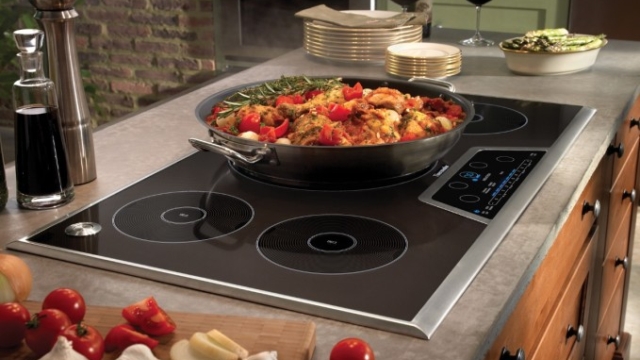
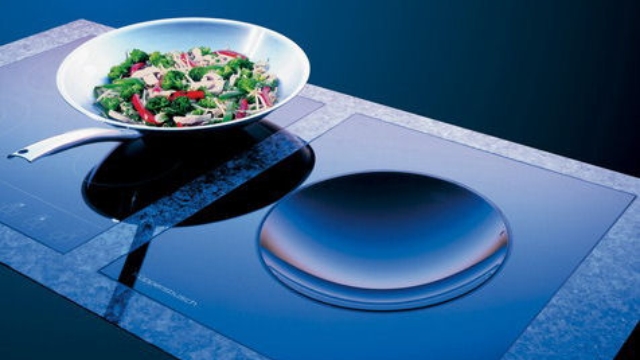
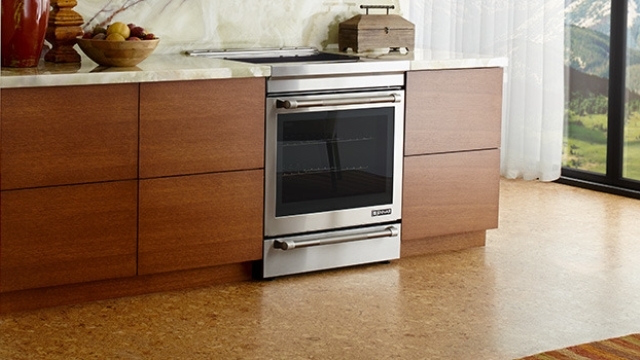
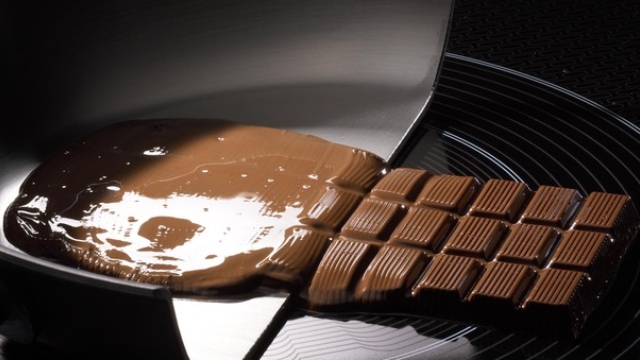
"A new scientific truth does not triumph by convincing its opponents and making them see the light, but rather because its opponents eventually die, and a new generation grows up that is familiar with it."
—Max Planck
Quick page jumps:
To serious cooks, the most important favorable point about induction cookers—given that they are as or more "powerful" at heating as any other sort—is that you can adjust the cooking heat instantly and with great precision. Before induction, good cooks, including all professionals, overwhelmingly preferred gas to all other forms of electric cooking for one reason: the substantial "inertia" in ordinary electric cookers—when you adjust the heat setting, the element (coil, halogen heater, whatever) only slowly starts to increase or decrease its temperature. With gas, when you adjust the element setting, the energy flow adjusts instantly.
But with induction cooking the heat level is every bit as instantaneous—and as exact—as with gas, yet with none of the many drawbacks of gas (which we will detail later). Induction elements can be adjusted to increments as fine as the cooker maker cares to supply (and nowadays that is very fine, especially at the critical low-temperatures end), and—again very important to serious cooks—such elements can run at as low a cooking-heat level as wanted for gentle simmering and suchlike (something even gas is not always good at). Someday, perhaps not so many years away, the world will look back on cooking with gas as we today look on cooking over a coal-burning kitchen stove.
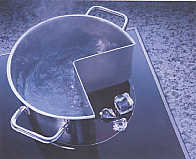
With induction cooking, energy is supplied directly to the cooking vessel by the magnetic field; thus, almost all of the source energy gets transferred to that vessel. With gas or conventional electric cookers (including halogen), the energy is first converted to heat and only then directed to the cooking vessel—with a lot of that heat going to waste heating up your kitchen (and you) instead of heating up your food. (The striking image at the left shows how precisely focussed heat generation is with induction—ice remains unmelted on an induction element that is boiling water!)
As a comparison, 40%—less than half—of the energy in gas gets used to cook, whereas with induction 84% percent (or, by many estimates, more) of the energy in the electricity used gets used to cook (and the rest is not waste heat as it is with gas). There are two important heat-related consequences of that fact:
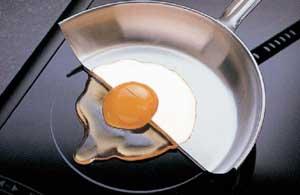
cooler kitchens: of course the cooking vessel and the food itself will radiate some of their heat into the cooking area—but compared to gas or other forms of electrically powered cooking, induction makes for a much cooler kitchen (recall the old saying: "If you can't stand the heat, get out of the kitchen."); and,
a cool stovetop: that's right! The stovetop itself barely gets warm except directly under the cooking vessel (and that only from such heat as the cooking vessel bottom transfers). No more burned fingers, no more baked-on spills, no more danger with children around. (The photo at the right—one of several similar ones to be found on the web—shows, like the one above, how only the cooking vessel does the actual cooking.)
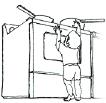
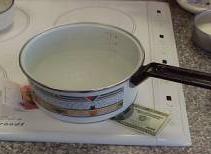
We have already mentioned that the stovetop stays cool: that means no burned fingers or hands, for you or—especially—for any small children in the household. (In the image at the right, you can see a pot boiling water on an induction unit while a dollar bill between the pot and the cooktop surface is unsinged.) And for kitchens that need to take into account special needs, such as wheelchair access, nothing, but nothing, can beat induction for both safety and convenience (see the paragraph farther below).
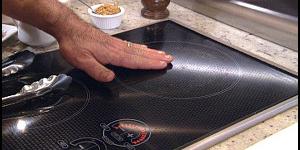
Furthermore, because its energy is transferred only to relatively massive magnetic materials, you can turn an induction element to "maximum" and place your hand flat over it with no consequences whatever—it will not roast your non-ferrous hand! (Nor any rings or bracelets—the units all have sensors that detect how much ferrous metal is in the area that the magnetic field would occupy, and if it isn't at least as much as a small pot, they don't turn on.) And, while an element is actually working, all of its energy goes into the metal cooking vessel right over it—there is none left "floating around" to heat up anything else. (The image at the left shows a hand—wearing a metal ring—harmlessly touching a full-on induction element, while a metal utensil lies equally harmlessly on another, emphatically demonstrating those points.)

Moreover, gas—induction's only real competition—has special risks of its own, not all of which are as well known as they perhaps should be. While the risk of a gas flame, even a pilot light, blowing out and allowing gas to escape into the house is relatively small, it does exist. But a much bigger concern is simply gas itself, even when everything is working "right". Use any web search engine and enter the terms gas health risk cooking and see what you find (really: do try it right here); if, for example, you visit the Gascape web site, you may never again want to even enter a house with gas laid on (take some time to really poke around on this site—you may be shocked). And, of course, all combustion releases toxic carbon monoxide.

Unlike most other types of cooking equipment, induction units are typically very thin in the vertical, often requiring not over two inches of depth below the countertop surface. When a cooking area is to be designed to allow wheelchair access, induction makes the matter simple and convenient. (In the image at the left, notice how the induction cooktop is scarcely any thicker than the actual countertop.)

It is an obvious but still very important fact that induction cookers are powered by electricity. Not every home actually has a gas pipeline available to it—for many, the only "gas" option is propane, with the corollary (and ugly, space-taking, potentially hazardous) propane tank and regular truck visits. But everyone has clean, silent, ever-present electricity.

Burning gas has byproducts that are vaporized, but eventually condense on a surface somewhere in the vicinity of the cooktop. Electrical cooking of any kinds eliminates such byproducts.
The most obvious and famous drawback to induction cooking has already been mentioned: it only works with cooking vessels made of magnetic materials. The commonest such materials used for cooking vessels are stainless steel and cast iron. Cookware suited for use with induction cookers, from the extreme high-quality end down to thrift-store modest, is readily available; but if you already have a stock of mostly expensive aluminum or copper or glass or pyrex cookware and little or no cast iron or stainless, you might be up for a cookware investment.
On the other hand, if you have a significant quantity of non-ferrous cookware that is not terribly expensive, you can replace it—possibly with much better stuff!—as part of the process; cast iron is by no means "spendy" cookware. If you have ever seen the inside of a real restaurant kitchen, you will surely have noticed that most or all of the cookware is either cast iron or nice, shiny stainless steel (even when they are still using gas for their cooking). Steel is most cooks' preferred cookware material for many good reasons we discuss elsewhere on this site (see the link below—and recall that enamelled steel cookware also works beautifully on induction.
(Note that not all stainless-steel cookware works equally well on induction units; much depends on how the maker has assembled the layers of metal of which the pot or pan is made. Do not assume that all cookware labelled "stainless steel" will work on an induction unit—but almost all makers whose products do work, which includes a lot, will proudly say so in their advertising material or specifications. The easiest test in the world is to take any magnet—a refrigerator-decor type works fine—and see if it will cling to the bottom of a piece of cookware. If it doesn't, or if it clings very weakly, that item of cookware will not work on an induction cooker. If you're shopping for cookware that you want to be able to use on an induction unit, now or in the future, just take such a magnet along with you. Or, if you're buying off the web, make sure the product description says the item is induction-compatible, or ask for a written or emailed statement that it is, with full refund privileges.)
For the curious, the difference is how much, if any, nickel was added to the stainless, as nickel kills magnetic fields; the sort labelled "18/0" is nickel-free, whereas "18/8" or "18/10" stainless has too much nickel to work effectively on induction cooktops. (Nickel is used because it tends to make a shinier steel.)
As we noted elsewhere, technology to allow use of any metal cookware—even copper and aluminum—is in the pipeline, but there are definite problems with getting sufficient power levels with that technique, so it will likely be many years before units with it start showing up in the mainstream (if they ever do). So, for now, the need for ferric cookware does remain.
(There are now, however, adaptors available that will allow any pot or pan to be used on an induction element; because they essentially turn an induction element into a standard stovetop type of heater, they lose many of the advantages of induction—they are less efficient, they get very hot, and may be restricted as to maximum power level—but if you have a special-purpose item of non-ferrous cookware, such as glass or ceramic, it can be made to work on induction.)
(To see what constitutes good cookware for induction, see our page on Induction Cookware.)
This is not a valid negative—but we list and discuss it here because there are so many falsehoods and misunderstandings floating around on this matter. As we clearly showed, with hard numbers, induction cooking units are not merely as powerful as even "pro" gas ranges (residential "pro", that is), they are almost invariably much more powerful. (And that's using conservative figures for both gas and induction efficiencies.) To recap, a top-line (and top-price) so-called "pro" home gas range might have burners each rated at 15,000 BTU/hour or, in a few cases, as much as 18,000 BTU/hour—but that is only about 2.1 to 2.5 kW for induction elements, and even the most modest cooktops have at least one element of at least 2.4 kW (and many have elements up to 3.6 or 3.7 kW or even more!). Any concern over the adequacy of the "cooking power" of induction units is simply silly and ignorant.
Owing to the length of quoted material involved in our discussion, we have put this topic on a page of its own; but the real scientific literature seems to show rather clearly that there are simply no radiation-associated hazards, even for those with imbedded cardiac devices. The fields are very localized, and in any event the cooking vessel absorbs virtually all of the field energy (and if there is no cooking vessel on an element, it won't turn on). You should certainly read about it for yourself, but claims of hazard seem quite groundless.
Induction itself is a noiseless process: the energy fields are generated by electronic equipment, which is silent. But even efficient electronics generates some heat. Whether the amount of heat generated can be dissipated "passively" (just by radiation and natural air flow, still silent) or requires a small fan to augment the air flow depends in good part on how tightly a given maker has packed how much power into how much space—some units have fans, some don't. But even on those with fans: one, the fan does not necessarily run all the time—usually just when the unit is running multiple elements at high settings—and two, such fans are normally pretty soft-sounding. There can also an occasional very soft "tick" sound, as the power controller cycles the elements on or off to keep the element power steady and stable.
What can sometimes produce sound with induction cooking is not the induction equipment but the cookware itself. Some of the possible causes include:
Encapsulated slugs in the base of the cookware: "clad" cookware (which is what any stainless-steel-finish cookware that works on induction is) has as its base a sort of "sandwich" of layers of several different metals (typically steel outside, aluminum or sometimes copper in the middle, and more steel inside); if the middle layer is merely encapsulated in the steel, as opposed to being actually welded within it, it can move about, however microscopically; but any such microscopic play can give rise to a sort of "buzzing" noise. On some other cooking surface, that buzzing won't happen, but the high-frequency oscillations of induction's magnetic field can cause it in lower-quality clad cookware (but even then, only on higher-power settings). When it occurs it's not typically loud, but it can annoy some people. Again: it's not the induction equipment, it's the less than ideal cookware, but it is an induction-related phenomenon.
Loose-fitting handles on cookware, typically when riveted on, can vibrate slightly.
Pans with irregular bottoms can vibrate audibly on the glass surface, though again typically only at high-power settings.
At high-power settings, lighter-weight lids may occasionally vibrate a bit.
Cookware of solid cast iron, including enamelware, is not subject to such issues; and clad cookware of better-quality lines should not be.
If the electricity supply to your home is interrupted, you will be unable to cook; gas supplies can be interrupted, too, but such interruptions are normally somewhat less likely than electricity interruptions. If the electricity where you are frequently goes out for hours at a time, the loss of cooking ability may be an issue for you. Most people living in such circumstances will have provided themselves with a backup, such as a propane-powered emergency generator—but if that's you and you have no backup, factor the matter into your decisions.
For those to whom charring such items as peppers in an open flame is important, the lack of such a flame is a drawback. (It is, of course, one shared with all non-gas cookers.) But nowadays, most good ovens—gas certainly, but probably even electric—can do an acceptable job of charring food.
Energy-cost differences are hard to reckon because the prices of gas and the price of electricity these days are highly volatile, even relative to one another (the DOE—the U.S. Department of Energy—reports that between 1999 and 2008, the national annual average residential natural gas price more than doubled), and vary considerably from locale to locale even on the same day at the same hour (and, of course, by season, too), sometimes by as much as a 3:1 ratio. But in any event, it is not a really large factor: according to the DOE (Table A.4), cooking accounts for only about 2.7 percent of an average home's energy use—and that use includes ovens, toasters, microwaves, and whatever else, not just stovetop cooking. The difference in cost for various cooktop energy sources is at most on the order of a couple of dollars a month.
Where does that come from? In November of 2009, on a national average, induction-cooking electricity cost about 1.43 times what gas-cooking cost (gas was $11.25 per thousand cubic feet, about 1,020,000 BTU, while electricity was 11.33 cents a kilowatt-hour, and 1 kilowatt-hour equals about 7,185 BTU). Overall household energy costs were estimated by one source—and this is a big variable—at $5 to $10 a day. Assuming, then $7.50 a day, that's about $228 a month, of which on average 2.7%, or roughly $6, goes for cooking costs. The 43% greater cost of electricity would be about $2.60, but that's way high because it assumes that all of the cooking energy is used for stovetop cooking, and that all households were using gas, the lowest efficiency method, for their cooking. So a couple of bucks a month is probably too high an estimate.)
As one often-cited energy resource site put it, Most people can't save much energy by changing their cooking methods. That site estimates saving about $13 a year for gas cooking rather than electric, and that's not induction electric, which is significantly more efficient than most other electricity-powered cooking methods. So perhaps even a buck a month difference is too high an estimate. In short, the energy cost differences just don't matter. (Which, of course, is why they're in this "neutral" category.)
It's hard to say that induction cooktops are "comparable" to gas cookers when induction-unit prices start at close to a thousand dollars: nonetheless, we will say it. The reason we do is because one needs to be careful to compare apples to apples, and the conventional 30-inch slide-in kitchen stove is an orange in this analogy. It is not always true that "you get what you pay for", but it is always true that you don't get what you don't pay for. An induction unit is so clearly superior, in so many ways, to any other form of cooking that it is hard to exaggerate the differences. One can say that a Chevy and a Rolls Royce are both "cars"—vehicles that take a given number of passengers from Point A to Point B—but there are valid reasons for the difference in their prices.
Moreover, a cooker—ordinary, fancy gas, induction, whatever—is a very long-term investment. The cost difference between a simple, inexpensive plain kitchen stove and a decent or better induction unit is not much when averaged out over the likely lifetime of such a unit. Moreover, consider: right now (early 2013), the top-ranked gas range on Consumer Search's list costs about $1,350; ranges topped with induction cooking surfaces range from $1,150 or so up, with a half-dozen under $1,500. That is awfully competitive. (Curiously, induction-topped ranges cost little more than induction cooktops.)
Cooking vessels at the extremes of size—the very small and the very large—occasionally raise issues. Because the auto-detect feature that all induction units have is meant to assure that things from cooking implements (such as metal tongs or spoons or ladles) to jewelry (rings or bracelets) will not activate an element, the detectors are often set rather conservatively, so much so that on some units very small pots or pans will not be detected (the usual minimum pot base size for activation is from 4 to 5 inches, depending on particular unit.) But that is scarcely a major issue: if you really must have such a pot—say "a butter warmer"—there are accessories available that make it easy.
At the other extreme—things like griddles or fish poachers that are well over 12 or 14 inches in at least one dimension—also present issues, or rather they used to. We still list this as a nagative because not all units can deal with such cookware, but nowadays a large and growing number feature "element bridging", which allows a matched pair of elements (commonly the left front and back pair) to be "bridged" so as to act as a single extra-long element, allowing things like griddles or fish pans to be satisfactorily accomodated.
Nonetheless, we list this as "neutral" because even un a unit without bridging, those issues are not substantively different from induction to, for example, gas. An induction element heats a cooking vessel placed on to the width of the element—just as with, for example, a gas burner. If one places a 12-inch-diameter skillet on a 9-inch induction element, the actual heat generation will take place in a 9-inch-diameter zone in the pan bottom; likewise, if one places the same skillet on a same-size gas burner, so also will the heating be limited to the size of the burner diameter. Heated cookware will do one of two things, depending on its construction (see out page on cookware for more detailed explanations): vessels designed to accomodate rapid changes in cooking temperature, such as clad stainless-steel cookware, will be correspondingly rapid in spreading heat throughout their total cooking area; vessels intended for even-temperature cooking, such as cast iron (enamelled or not), will be slower to achieve temperature equilibrium, but once well heated will hold temperatures pretty even and constant across their total cooking area.
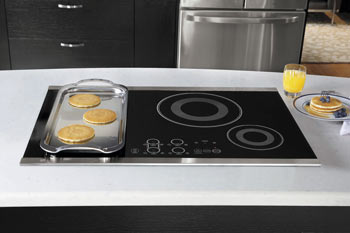
And today, for those for whom such considerations loom large, there are several induction units available with true "bridged" element pairs (as shown in the image at the left); that means that on a given unit, some same-size pair of elements (it seems to typically be the left-hand front/back pair) can be set as a "bridged pair" making them effectively one long single element, such that a grill or griddle or fish pan will work well on them.
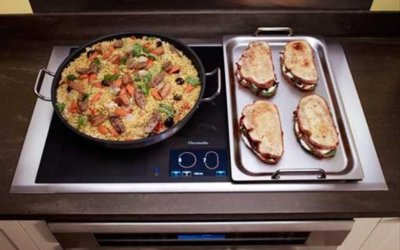
Moreover, for those with truly unusual needs, there are now "zoneless" units that will take any size or shape vessel you can set down on them (as shown in the image at the right). Zoneless is, so far, still pretty pricey, but units with bridging are little if any different in price from others of their general size and quality.
If you would like to take a current look at what is being said about induction cooking by actual users, not "authorities", here are some direct links. Each will do a realtime Google search for the word induction used in any discussion. The first is an especially good web resource; the other two are usenet ("groups") discussion forums. The difference between the last two is that one will search one set of groups—all those with the word cooking anywhere in their name—and the second another group, all those with the word food anywhere in their name (of course, there will be some overlap between those two sets of results, notably rec.food.cooking):
the GardenWeb forums, where much and frequent discussion of induction equipment and cooking is to be found.
the rec.food.cooking Usenet group (a forum)
The GardenWeb posters tend to be everyday folk; the usenet posters tend to be more various. In any event, using these links gives you a set of results over which we have no control at all, so it's as unbiased as it gets (the selection is unbiased: many of the posters will be highly biased one way or another—see the text immediately below for examples of what we mean).

No, not the cookware you might use, but the crackpots who post nonsense about subjects about which it is manifest that they are sorely uninformed, thus creating false worries in the minds of those who expect authoritative-sounding posts to actually be authoritative. As some wit once remarked, "There is no harm in being a fool; harm lies in being a fool at the top of your lungs." And the internet, whether the web or usenet, is chock full of cracked pots apparently willing to be fools at the tops of their lungs about induction cooking and induction equipment.
We used to have here a little selection of cracked-pot postings, with our explanatory comments appended, but there's really little point to it now. Once, when so little was generally known about induction in North America, cracked pots could get away with posting ignorant (and usually snotty) nonsenses about the inferiority of induction and the supposed vast superiority of gas—but those days are gone now.
Not that there aren't likely to still be a lot of cracked pots out there—this is the human race we're talking about—but hard, factual data is now readily adduced. One could, for example, if given to being tediously supererogatory, compile a long laundry list of top-rank chefs and restaurants that use, and extravagantly endorse, induction equipment, as a sort of "Take that!" to those who insists that "the pros" use nothing but gas; but there would be no point except to prove a willingness to scan a lot of web pages, because so very many top chefs and restaurants would make that list.
The old guff seemed to be especially based on the purported weakness of induction units beside gas cookers; today, to anyone who can read without moving their lips, that scarcely rises even to the level of being humorous—it's just so silly. Remember, for comparing induction with gas:
gas BTU/hour = induction kW x 7185
Most household units have at least 2.4 kW elements, and many have 3.6 kW; that is very conservatively equivalent, for gas cooking, to 17,000 BTU up to just almost 26,000 BTU. That is cooking power, and it's commonplace in home units. Nuff said, hm?
Although this site is about the clear superiority of induction to any other method of cooking, we really have tried to give as balanced a picture as possible. If it seems to you, after reading this page, that we have skewed toward the favorable, that is only because induction really is immensely superior. Its sole consequential drawback is its inability to work with certain kinds of cookware—which is not an inherent flaw, because it works with the very best—but which can be a drawback is you are at present heavily invested (whether in a dollar or in an emotional sense) in incompatible cookware.
(And don't forget to see our page on Induction Cookware.)
You can now explore the rest of this site as you please, but if you want to jump straight to some hard data on real induction-cooking units, the logical next stop is our page on Induction-Cooking Manufacturers and Their Products. Or, if you want a fuller background on the "how and why", check our "mini-course" at Kitchen Electricity 101.
Advertisement:
Advertisement:
All content copyright © 2002 - 2025 by The Owlcroft Company.
This web page is strictly compliant with the W3C (World Wide Web Consortium) Extensible HyperText Markup Language (XHTML) Protocol v1.0 (Transitional) and the W3C Cascading Style Sheets (CSS) Protocol v3 — because we care about interoperability. Click on the logos below to test us!
This page was last modified on Monday, 22 January 2024, at 12:46 am Pacific Time.